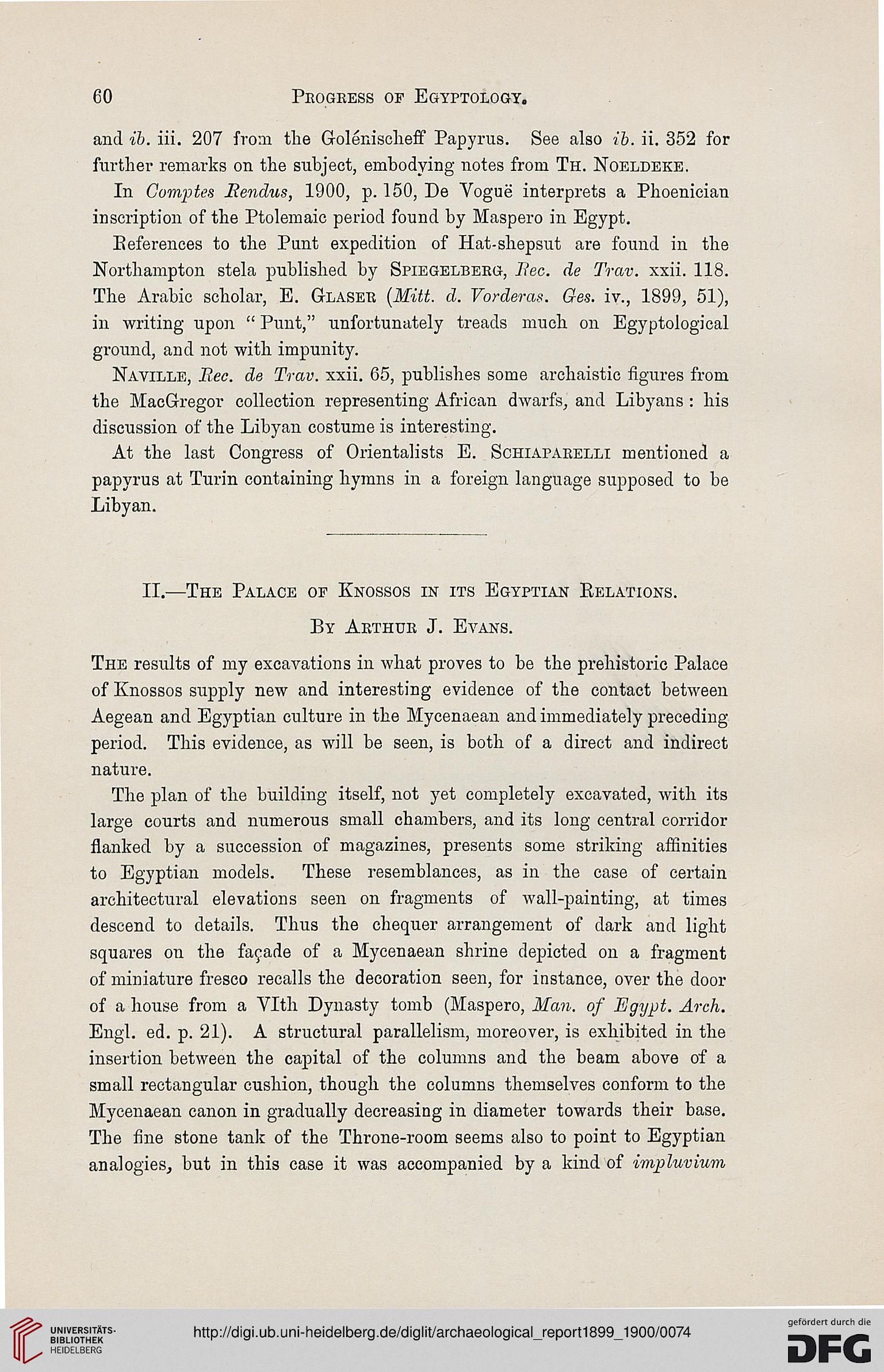(iO
Progress of Egyptology.
and ib. iii. 207 from the G-olenischeff Papyrus. See also ib. ii. 352 for
further remarks on the subject, embodying notes from Th. Noeldeke.
In Comptes JRendus, 1900, p. 150, De Vogue interprets a Phoenician
inscription of the Ptolemaic period found by Maspero in Egypt.
References to the Punt expedition of Hat-shepsut are found in the
Northampton stela published by Spiegelbeeg, liec. de Trav. xxii. 118.
The Arabic scholar, E. Glaseb (Mitt. d. Vorderas. Ges. iv., 1899, 51),
in writing upon " Punt," unfortunately treads much on Egyptological
ground, and not with impunity.
Naville, Eec. de Trav. xxii. 65, publishes some archaistic figures from
the MacGregor collection representing African dwarfs, and Libyans : his
discussion of the Libyan costume is interesting.
At the last Congress of Orientalists E. Schiapaeelli mentioned a
papyrus at Turin containing hymns in a foreign language supposed to be
Libyan.
II.—The Palace of Knossos in its Egyptian Relations.
By Aethue J. Evans.
The results of my excavations in what proves to be the prehistoric Palace
of Knossos supply new and interesting evidence of the contact between
Aegean and Egyptian culture in the Mycenaean and immediately preceding-
period. This evidence, as will be seen, is both of a direct and indirect
nature.
The plan of the building itself, not yet completely excavated, with its
large courts and numerous small chambers, and its long central corridor
flanked by a succession of magazines, presents some striking affinities
to Egyptian models. These resemblances, as in the case of certain
architectural elevations seen on fragments of wall-painting, at times
descend to details. Thus the chequer arrangement of dark and light
squares on the facade of a Mycenaean shrine depicted on a fragment
of miniature fresco recalls the decoration seen, for instance, over the door
of a house from a Vlth Dynasty tomb (Maspero, Man. of Egypt. Arch.
Engl. ed. p. 21). A structural parallelism, moreover, is exhibited in the
insertion between the capital of the columns and the beam above of a
small rectangular cushion, though the columns themselves conform to the
Mycenaean canon in gradually decreasing in diameter towards their base.
The fine stone tank of the Throne-room seems also to point to Egyptian
analogies, but in this case it was accompanied by a kind of impluvium
Progress of Egyptology.
and ib. iii. 207 from the G-olenischeff Papyrus. See also ib. ii. 352 for
further remarks on the subject, embodying notes from Th. Noeldeke.
In Comptes JRendus, 1900, p. 150, De Vogue interprets a Phoenician
inscription of the Ptolemaic period found by Maspero in Egypt.
References to the Punt expedition of Hat-shepsut are found in the
Northampton stela published by Spiegelbeeg, liec. de Trav. xxii. 118.
The Arabic scholar, E. Glaseb (Mitt. d. Vorderas. Ges. iv., 1899, 51),
in writing upon " Punt," unfortunately treads much on Egyptological
ground, and not with impunity.
Naville, Eec. de Trav. xxii. 65, publishes some archaistic figures from
the MacGregor collection representing African dwarfs, and Libyans : his
discussion of the Libyan costume is interesting.
At the last Congress of Orientalists E. Schiapaeelli mentioned a
papyrus at Turin containing hymns in a foreign language supposed to be
Libyan.
II.—The Palace of Knossos in its Egyptian Relations.
By Aethue J. Evans.
The results of my excavations in what proves to be the prehistoric Palace
of Knossos supply new and interesting evidence of the contact between
Aegean and Egyptian culture in the Mycenaean and immediately preceding-
period. This evidence, as will be seen, is both of a direct and indirect
nature.
The plan of the building itself, not yet completely excavated, with its
large courts and numerous small chambers, and its long central corridor
flanked by a succession of magazines, presents some striking affinities
to Egyptian models. These resemblances, as in the case of certain
architectural elevations seen on fragments of wall-painting, at times
descend to details. Thus the chequer arrangement of dark and light
squares on the facade of a Mycenaean shrine depicted on a fragment
of miniature fresco recalls the decoration seen, for instance, over the door
of a house from a Vlth Dynasty tomb (Maspero, Man. of Egypt. Arch.
Engl. ed. p. 21). A structural parallelism, moreover, is exhibited in the
insertion between the capital of the columns and the beam above of a
small rectangular cushion, though the columns themselves conform to the
Mycenaean canon in gradually decreasing in diameter towards their base.
The fine stone tank of the Throne-room seems also to point to Egyptian
analogies, but in this case it was accompanied by a kind of impluvium





